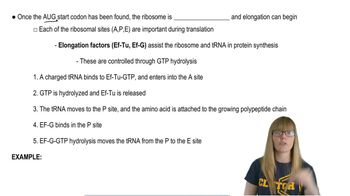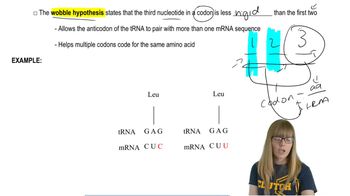Table of contents
- 1. Introduction to Genetics51m
- 2. Mendel's Laws of Inheritance3h 37m
- 3. Extensions to Mendelian Inheritance2h 41m
- 4. Genetic Mapping and Linkage2h 28m
- 5. Genetics of Bacteria and Viruses1h 21m
- 6. Chromosomal Variation1h 48m
- 7. DNA and Chromosome Structure56m
- 8. DNA Replication1h 10m
- 9. Mitosis and Meiosis1h 34m
- 10. Transcription1h 0m
- 11. Translation58m
- 12. Gene Regulation in Prokaryotes1h 19m
- 13. Gene Regulation in Eukaryotes44m
- 14. Genetic Control of Development44m
- 15. Genomes and Genomics1h 50m
- 16. Transposable Elements47m
- 17. Mutation, Repair, and Recombination1h 6m
- 18. Molecular Genetic Tools19m
- 19. Cancer Genetics29m
- 20. Quantitative Genetics1h 26m
- 21. Population Genetics50m
- 22. Evolutionary Genetics29m
11. Translation
Translation
Problem 38a
Textbook Question
Textbook QuestionOrganisms of all three domains of life usually use the mRNA codon AUG as the start codon.
Despite AUG being the most common start codon sequence, very few proteins have methionine as the first amino acid. Why is this the case?
 Verified Solution
Verified SolutionThis video solution was recommended by our tutors as helpful for the problem above
Video duration:
3mPlay a video:
Was this helpful?
Key Concepts
Here are the essential concepts you must grasp in order to answer the question correctly.
Start Codon and Translation Initiation
The start codon, AUG, is crucial in the process of translation, marking the site where protein synthesis begins. It codes for the amino acid methionine, which is typically the first amino acid in newly synthesized proteins. However, the presence of AUG does not guarantee that methionine will be the first amino acid in the final protein product.
Recommended video:
Guided course

Translation initiation
Post-Translational Modifications
After translation, proteins often undergo post-translational modifications, which can alter their structure and function. These modifications may include the removal of the initial methionine residue, leading to proteins that do not have methionine as their first amino acid. Such modifications are essential for the protein's activity and stability.
Recommended video:
Guided course

Post Translational Modifications
Alternative Start Codons
In some cases, proteins can initiate translation at alternative start codons, which may lead to different amino acids being incorporated at the beginning of the protein. This phenomenon can result from variations in the mRNA sequence or the presence of specific regulatory elements, contributing to the diversity of protein structures and functions.
Recommended video:
Guided course

Alternative DNA Forms

 7:58m
7:58mWatch next
Master Translation initiation with a bite sized video explanation from Kylia Goodner
Start learning



